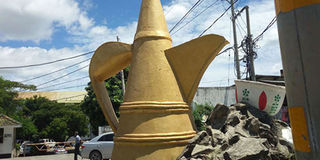Premium
Omani culture alive and well in Old Town

The coffee pot near Fort Jesus at Old Town, Mombasa County. It symbolises the Omani tradition. PHOTO | DIANA MUTHEU | NATION MEDIA GROUP
What you need to know:
- Mr Mohammed, who was born and raised in Old Town, said the kettles come in different sizes, but the coffee cups are always small and have beautiful flower patterns.
- Popularly known as Habloo, the old man makes sweet and bitter coffee. The bitter version is called “kahawa tungu” among the locals.
Near the entrance of the iconic Fort Jesus in Mombasa is a small roundabout with a huge metallic coffee pot and tumblers.
Looking at them, you might think that some unseen hand is pouring coffee from the pot into the tumblers, which are arranged in such a way that one is full, it overflows to the next and the cycle continues.
The small area is outstanding in its own right although it is surrounded by the iconic Fort Jesus and the great Old Town.
The coffee pot and tumblers are a great tourist attraction, with local and foreign tourists often eager to take photos with them providing the backdrop. Some even take videos and photos from their cars.
A stone plaque near the pot reads: “This coffee pot, a gift to Mombasa County, was built by Mr Ali Taher in the year 1988 and under the initiative of the Mombasa and Coast Tourist Association. It was refurbished by Mr Mohamed Haji Aboo in the year 2001.”
Mr Ali also owned Ali’s Curio Shop on Ndia Kuu Road in Old Town.
MARKETING CULTURE
Mr Shariff Mohammed, a tour guide in the area, said the coffee pot was installed to show that alcohol was not sold in Old Town, and that the area was occupied by Muslims.
“Mr Ali built the large kettle so that it could attract visitors. The pot symbolises the traditional culture of the Omani people, who make coffee in a big pot and drink it from small tumblers,” Mr Mohammed said.
Mr Mohammed, who was born and raised in Old Town, said the kettles come in different sizes, but the coffee cups are always small and have beautiful flower patterns.
Perhaps that is why there are drawings of a hand pouring coffee into tumblers in Old Town.
Not surprisingly, the residents of Old Town have maintained the culture of making coffee in big pots and serving it in tiny cups.
Mr Habloo Nassir, 65, runs a coffee stand beside the small park near Fort Jesus. He has been operating here for more than five years, selling a tumbler at Sh10.
“The business does not bring in much money, but I feel fulfilled since I’m promoting my culture,” Mr Nassir said.
EVENING BREAK
Popularly known as Habloo, the old man makes sweet and bitter coffee. The bitter version is called “kahawa tungu” among the locals. The coffee is spiced with ginger, cinnamon and cardamom.
“Most people take the coffee in the evening after work. Even women make the coffee at home for their families,” Mr Nassir says.
Even as he does his work, he’s ready to explain to visitors what the big coffee pot and tumblers some 40 metres from his stand symbolise.
Also in the small area is a street trolley, about a metre long, a remnant of the original railway line built in 1890 to connect Old Town and the Kilindini harbour.
Street trolleys were used in Mombasa as the main means of transport between 1890 and 1920. They consisted of hand-pushed trolleys along narrow-gauge rails.
Is there a site you want us to feature? Write an e-mail to [email protected]



